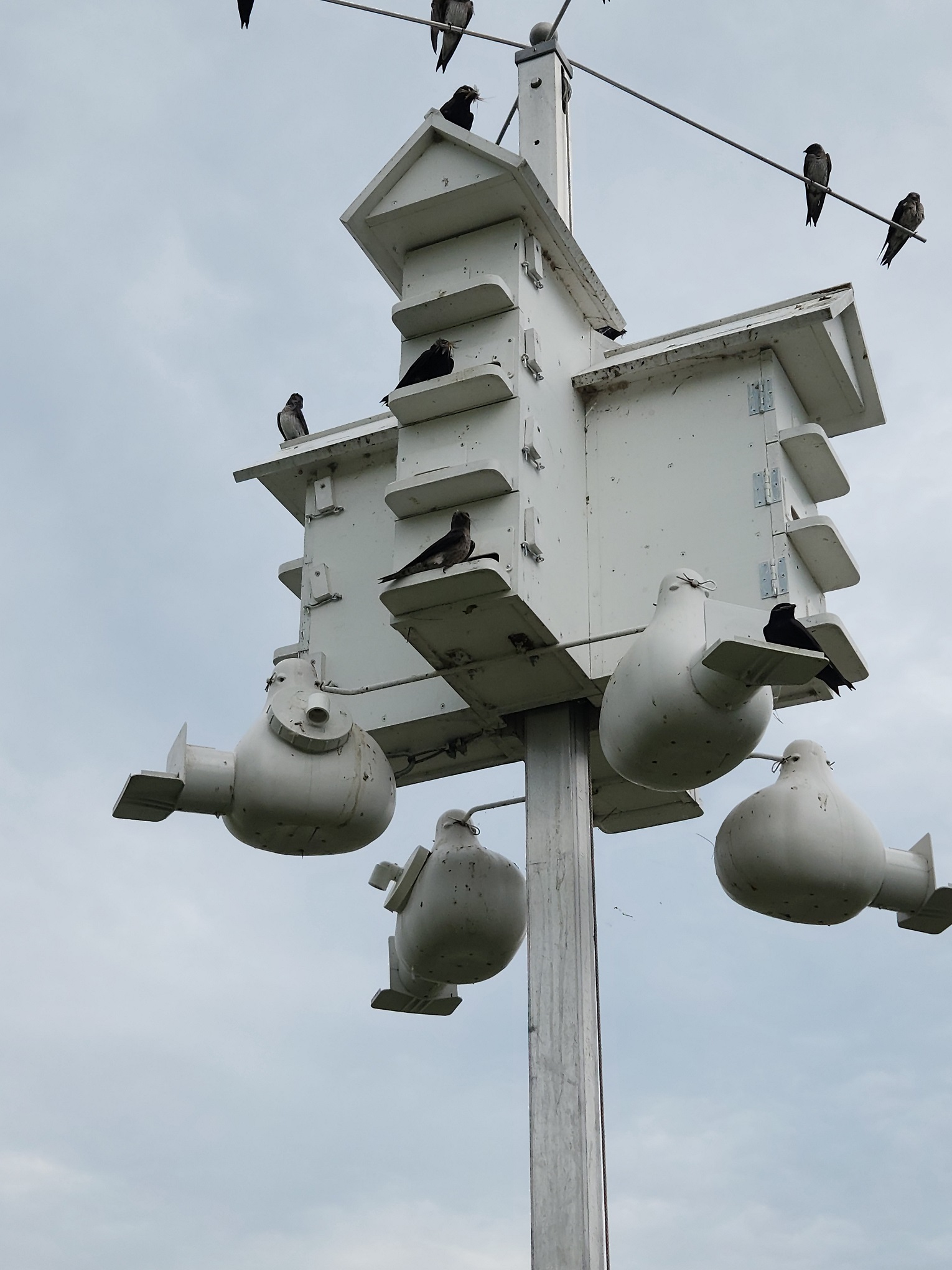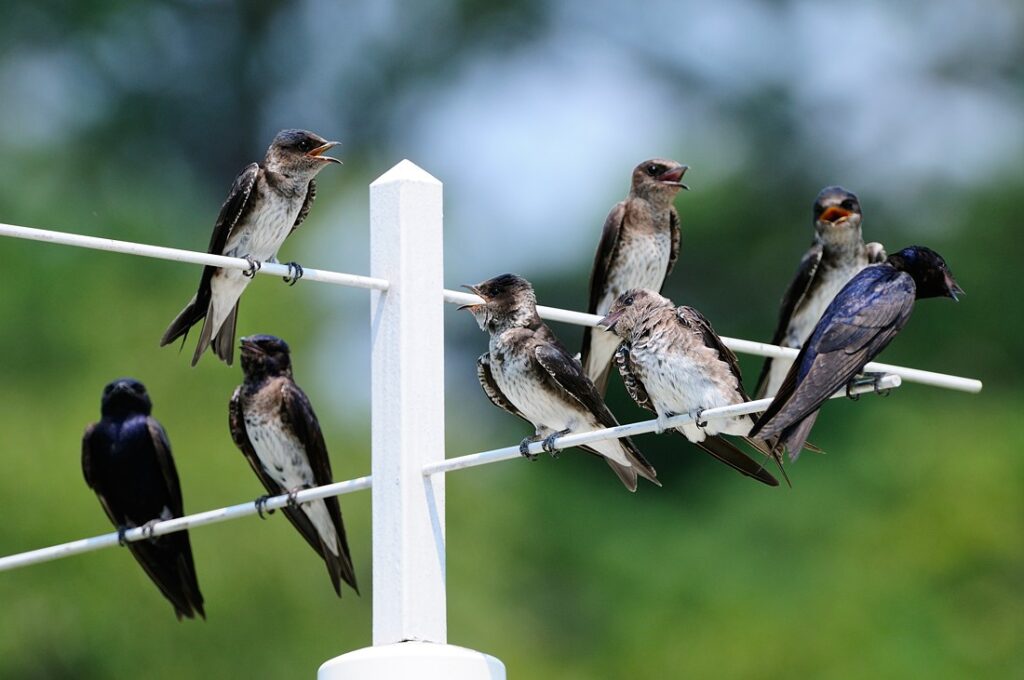Ontario's Purple Martin
- Overview
- ID Info
- Life Story
- Maps
- Communication
Purple Martins are fairly common birds, especially in the southeastern U.S., but their numbers declined by approximately 0.5% per year, resulting in a cumulative decline of about 25% between 1966 and 2019, according to the North American Breeding Bird Survey. Partners in Flight estimates the global breeding population at 9.3 million and rates them 10 out of 20 on the Continental Concern Score, indicating a species of relatively low conservation concern. Canadian populations of aerial insectivores are experiencing sharp declines and the cause is not clear. In Ontario alone, the Purple Martin population has been declining by over seven percent annually, since monitoring began in 1970. You can help to replenish populations by putting up a single Purple Martin house, so a miniature neighborhood of birds can develop in your backyard. Usually dark, glossy-blue males and brown females will peer from the entrances and chirp from the rooftops all summer long in your Ontario backyard. These aerial acrobatics will perform right in front of you as they snap up flying insects and feed their young. Later in the Summer, they will gather in large flocks called roosts to head south. If you are looking to find out more information about their identification, biology, migration, management, or martin housing, you will be able to find it here.
- Purple Martins and aerial insectivores are totally dependent on man-made housing. They face great threats as they journey from South America each Spring. Why are Purple Martins, the largest of Swallows in decline in Ontario? It could be due to a number of factors which include Climate Change, Pesticides and Pollutants, Lack of Suitable Housing, Invasive Species, Natural predators, Uncertain Spring Weather, Lack of Suitable Food sources along with their migration as well as death by domestic cats. Assist and preserve this Swallow Species by learning about their special requirements and housing needs.
In 2016, Nature Canada decided to put forth a tremendous effort to re-establish and increase the number of Purple Martins in Ontario by putting up Martin housing units called T-14s throughout the province. Under the direction of Mr. Ted Cheskey, the project has been going on for over 5 years. More information about this Nature Project can be found at Purple Martin Project.
- Identification
- Photo Gallery
Many thanks to the PMCA and Tara Dodge for sharing this image.
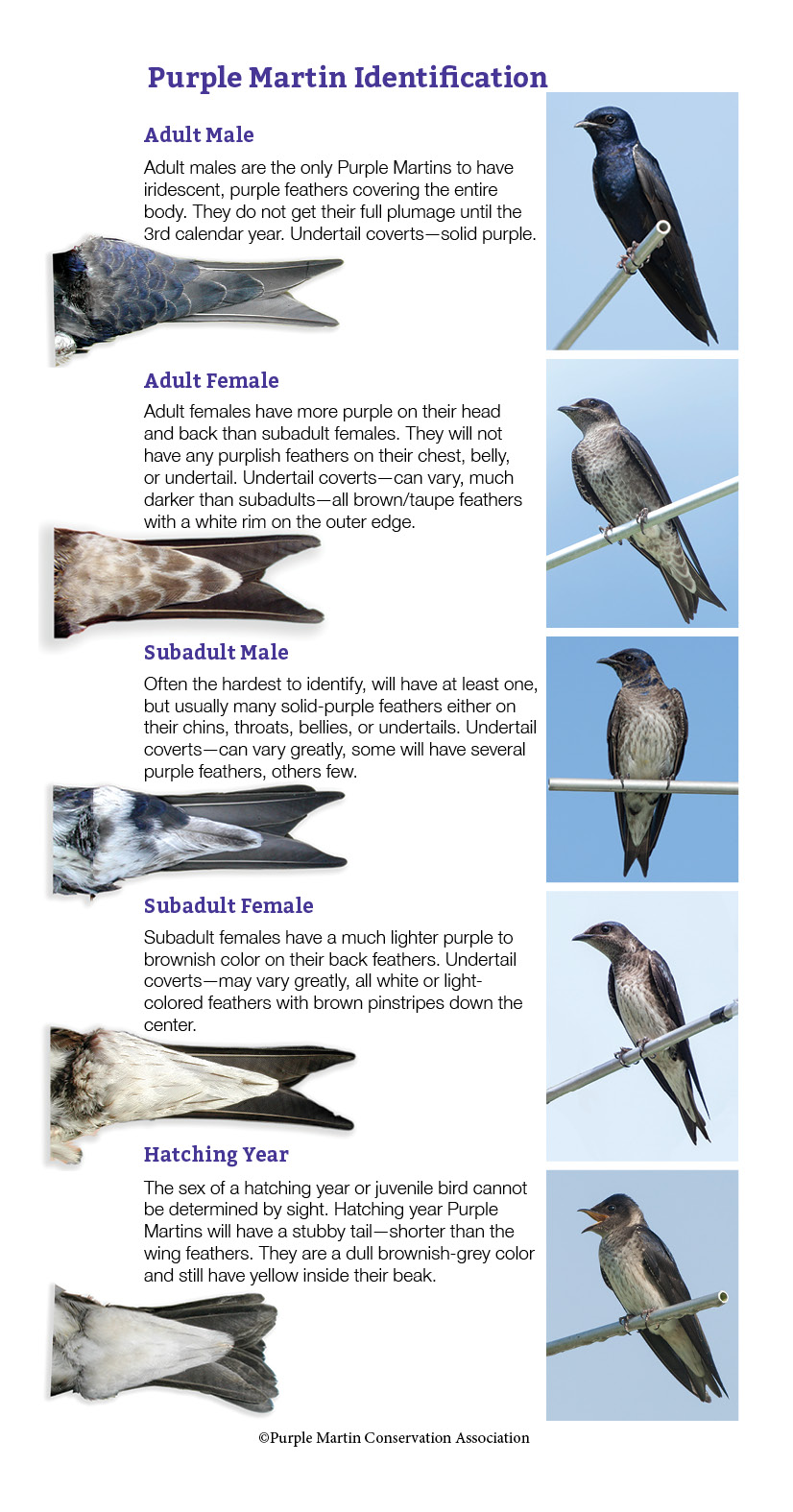
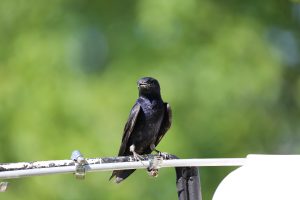
ASY male
Large Broad chested swallow with a slightly hooked bill and long tapered wings. Adult males are iridescent, dark blue-purple overall with brown black wings and tail.
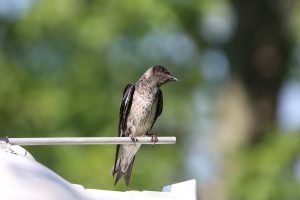
ASY female
Females are a large and chunky swallow with variable amounts of gray on the head and chest with a dingy coloured belly. Some have a grey coloured collar.
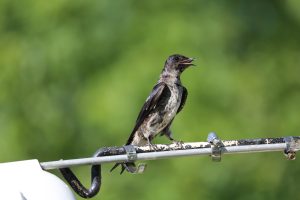
SY male
Subadult males are often the hardest to identify and will have at least one, but usually many solid-purple feathers either on their chins, throats, bellies, or under their tails. They are often confused with adult females.
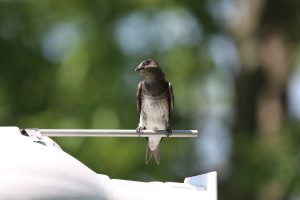
SY female
Subadult females have a much lighter purple to brownish color on their back feathers. Under tails are all white or light-colored feathers with brown pinstripes down the center.
- Identification
- Photo Gallery
Many thanks to the PMCA and Tara Dodge for sharing this image.


ASY male
Large Broad chested swallow with a slightly hooked bill and long tapered wings. Adult males are iridescent, dark blue-purple overall with brown black wings and tail.

ASY female
Females are a large and chunky swallow with variable amounts of gray on the head and chest with a dingy coloured belly. Some have a grey coloured collar.

SY male
Subadult males are often the hardest to identify and will have at least one, but usually many solid-purple feathers either on their chins, throats, bellies, or under their tails. They are often confused with adult females.

SY female
Subadult females have a much lighter purple to brownish color on their back feathers. Under tails are all white or light-colored feathers with brown pinstripes down the center.
Habitat
Ontario’s Purple Martins forage over towns, cities, parks, open fields, dunes, streams, wet meadows, beaver ponds, and other open areas. Sometimes dead snags offer abandoned woodpecker holes to nest in and martins take advantage of them if there is no man made housing available. Ontario’s Purple Martin seems to be totally dependent on nest boxes and likes to live close to humans. Purple Martins are neo-tropical and spend their winter in Bolivia, Brazil, and elsewhere in South America especially in the Amazon region. At night, wintering large flocks of martins settle into cities and towns to roost on buildings or trees or onto treed islands located on the Rio Negro in the Amazon region.
Feeding Behavior
The Purple Martin eats flying insects at altitudes higher than most swallows, often exceeding 50 meters and sometimes 150 meters or more off the ground. When they encounter prey, they will often turn suddenly, speed up, and then open their tails as they trap the insect. The Purple Martin diet may include: beetles, flies, dragonflies, damselflies, leafhoppers, grasshoppers, crickets, butterflies, moths, wasps, bees, caddisflies, spiders, cicadas, termites, and mayflies. They usually feed during the day and often in pairs. Martins pick up small bits of gravel or egg shells to help them with digestion . In an emergency, they will often take flung crickets or even scrambled eggs.
NEST PLACEMENT
Males will often arrive early in the season to claim a particular nesting site and rigorously defend it from other males. Afterwards, both sexes will often visit various house cavities before choosing the final location. Sometimes they may claim two compartments and rigorously defend them both from other martins. The cavity may be located in a birdhouse, gourd, dead tree, saguaro cactus, building, or cliff, but sometimes in other structures like traffic lights, street lamps, dock pilings, or oil pumps. Purple Martin birdhouses and gourds are either natural, made of wood or aluminum, and contain 8–12 rooms. Housing units can be hung from wires or sit atop poles in open areas and can be made to raise and lower.
NEST DESCRIPTION
Ontario’s martins usually nest in birdhouses provided by humans. Seldom do they nest in woodpecker holes in trees since their numbers are severely in decline. Nests usually contain twigs, plant stems, mud, bean straw, grass or pine straw.
NESTING FACTS
Eggs and Young
Clutch Size: 3-6 eggs
Number of Broods: Usually 1 brood
Egg Length: 0.8-1.1 in (2.1-2.7 cm)
Egg Width: 0.6-0.8 in (1.6-1.9 cm)
Incubation Period: 15-18 days
Nestling Period: 27-36 days
Egg Description: Pure white and smooth.
Condition at Hatching: Weak, with completely bare pink skin.
Ontario Conservation status
Ontario’s Purple Martins are fairly common birds, especially in the southeastern U.S., but their numbers declined by approximately 0.5% per year, resulting in a cumulative decline of about 25% between 1966 and 2019, according to the North American Breeding Bird Survey. Partners in Flight estimates the global breeding population at 9.3 million and rates them 10 out of 20 on the Continental Concern Score, indicating a species of relatively low conservation concern. Humans have helped counteract declines somewhat by putting up nest boxes, and people now provide virtually all nest sites for Purple Martins in the eastern U.S. However, introduced species such as European Starlings and House Sparrows often take over martin houses and injure or kill eggs and nestlings. Purple martins compete with these invasive house sparrows and European starlings for nesting sites (Brown, 1997; Fraser, et al., 1997)
Purple Martins are also sensitive to cold snaps; bad weather kills more birds than all other sources of mortality combined. When unseasonably cold temperatures last more than three or four days, the birds starve for lack of insects. In the western U.S., logging practices that remove dead trees can reduce nesting habitat for martins. Reduction of pesticide use on their South American wintering grounds and protection of large winter roosts in Brazil is also important to the conservation of this species.
Lifespan/Longevity
The longevity of purple martins ranges from 0 to 13 years and nine months. Purple martin mortality is often the result of severe weather. Three to four days of severe weather can lead to insect numbers drastically declining. If there is a lack of food, purple martins cannot survive and this often results in population decline. Another hindrance to long life expectancy is often body parasites. Purple martins host a protozoan blood parasite Haemoproteus prognei. This parasite can have disastrous effects on the surviving rate of first year birds during the winter and migration period. (Brown, 1997; Layton, 1972)
Geography
CONTINENTS
SUBCONTINENTS
COUNTRIES
BIOGEOGRAPHICAL REALMS
WWF BIOMES

Purple Martin habitat map
Purple martins breed across eastern North America, and also some locations on the west coast from British Columbia to Mexico. In winter, these birds migrate to the Amazon basin. Purple martins inhabit open areas near wetlands, swamps, and wet meadows. They can be found along forest edges, in mountain forests, shrubland, agricultural areas, farms, and in urban settlements.
Purple martins communicate vocally and visually. Purple martins have eleven identified vocalizations that they use for different occasions like mating, warning, and teaching the young during fledging. Male purple martins use singing and visual displays to attract potential female mates. Juvenile purple martins resort to ‘choo-choo’ calls to attract their parents’ attention if protection is needed. Parents use juvenile ‘choo-choo’ calls to assemble their broods and return them safely to the nest. Female purple martins use the ‘choo’ call to lead their young to and from groupings areas during the fledging period. Purple martins only resort to ‘zwarck’ calls when they need to send a high intensity alarm, and it is often accompanied by the birds diving straight down towards the invader. Male purple martins use ‘hee-hee’ vocalizations to fight off intruders. ‘Zweet’ calls are used to show intraspecific excitement, as well as send an alarm to warn other purple martins of a potential threat and to encourage them to fly away. Purple martins use ‘cher’ calls to communicate daily and will use ‘chortle’ calls in high excitement situations. Males attract females by singing ‘croak songs’ as well as to warn off unmated males from entering their territory. During courtship males make a clicking sound by snapping their lower and upper mandibles together. The last vocalization male purple martins use are ‘subsongs’ and are heard during feeding and pre-migratory periods. ‘Subsongs’ are used to communicate with other purple martins while socializing together. Purple martin males that are part of a stable colony often perform a ‘dawnsong’ which include a variety of sounds early in the morning. (Brown, 1978; Brown, 1984; Brown, 1997; Johnston and Hardy, 1962; Morton, 1985)
Supplemental Feeding of Purple Martins When Insects are in Short Supply
Martins feed only on flying insects, so they need to be “trained” to recognize crickets, mealworms, and cooked eggs as food when the weather is not conducive to foraging. Tossing or propelling food items into the air cues the martins to go after the food, so this is usually the best way to begin supplemental feeding. Afterward, they can be trained to feed from a platform. Follow the YouTube video to see the Martins adjust to the platform feeding scrambled eggs on May 1, 2023 Platform Feeding Summer feeding is also recommended when insects are not available to the martins. Further information is available on this website: https://ontariopurplemartins.ca/emergency-feeding/
Purple Martin Growth
Feeding Behavior
Forages almost entirely in the air. May forage very low over water, or quite high at times. Occasionally walks about on ground to pick up insects, perhaps mostly in harsh weather.
Eggs
4-5, sometimes 3-8. White. Incubation is by female, 15-18 days. Young: Both parents feed nestlings. Young leave nest about 26-31 days after hatching.
Nesting
Males return to nesting areas first in spring, establish nesting territories. Usually nests in colonies, especially in east, where almost all are in multiple-roomed nest boxes put up for them.
Recent Blogs
No posts found!
